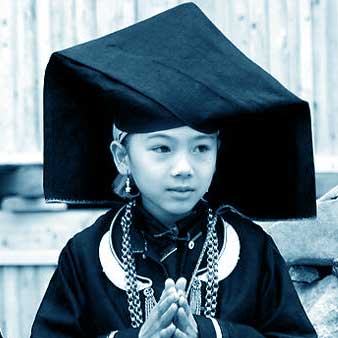 COM.on C.A.4:e4/21-25
Online published on Apr.12, 2010.
COM.on C.A.4:e4/21-25
Online published on Apr.12, 2010.doi:10.4236/coca.2010.41004
 COM.on C.A.4:e4/21-25
Online published on Apr.12, 2010.
COM.on C.A.4:e4/21-25
Online published on Apr.12, 2010.ZHAO Qing 1,2, PAN Shangling 1, QIN Zhendong 2, CAI Xiaoyun 2, LU Yan 2, XU Jieshun 3, YIN Ruixing 4, LI Shilin 2, JIN Li 2, LI Hui 2
1 Department of Pathophysiology, Guangxi Medical University, Nanning 530021 China; 2 State Key Laboratory of Genetic Engineering and MOE Key Laboratory of Contemporary Anthropology, School of Life Sciences and Institutes of Biomedical Sciences, Fudan University, Shanghai 200433 China; 3 School of Ethnology and Sociology, Guangxi University for Nationalities, Nanning 530006 China; 4 Institute of Cardiovascular Disease, Guangxi Medical University, Nanning 530021 China.
Key words: Minz Zhuang; Tai ethnic group; Y chromosome; Mitochondrial DNA
Recieved: Apr.8, 2010 Accepted: Apr.11, 2010 Corresponding: sl_pan6@hotmail.com
《现代人类学通讯》第四卷e4篇 第21-25页 2010年4月12日网上发行
研究报告
广西那坡黑衣壮族是泰老民族南迁途中的遗留群体
赵青1,2,潘尚领1,覃振东2,蔡晓云2,陆艳2,徐杰舜3,尹瑞兴4,李士林2,金力2,李辉2
1 广西医科大学基础医学院,南宁 530021;2 复旦大学生命科学学院现代人类学教育部重点实验室,上海 200433;3 广西民族大学民族学与社会学学院,南宁 530006; 4 广西医科大学心血管研究所,南宁 530021
摘要: 中南半岛的泰老民族被认为是中国广西的壮傣族群南迁形成的。那坡县地处中越边境滇桂交界地区,泰老民族南迁可能经过该地。那坡县的黑衣壮族是现在壮族群体中保留传统最多的,很可能是壮傣群体南迁途中遗留的群体。本文研究了黑衣壮族的Y染色体和线粒体多样性。结果发现,黑衣壮是典型的壮傣群体,但又有一些来源复杂的成分。从广西东部往西南,通过那坡,一直到老挝,Y染色体的多样性基本呈现降低趋势,证实了壮傣的南迁。而黑衣壮族与老挝群体共享许多STR单倍群,支持黑衣壮族是泰老民族南迁途中遗留群体的观点。
关键词: 黑衣壮族;壮傣族群;Y染色体;线粒体
收稿日期:2010年4月8日 修回日期:2010年4月11日 联系人:潘尚领 sl_pan6@hotmail.com
致谢
感谢所有为本课题提供样本的志愿者。广西医科大学林伟雄老师和罗晓秋等同学参与了 DNA 抽提工作。感谢那坡县人民政府农敏坚书记对采样工作的大力协助和支持。本项目得到以下基金部分支持:国家自然科学基金(39993420, 30890034, 30360038), 广西自然科学基金(GSN0728160);国家杰出青年科学基金(30625016),863项目(2007AA02Z312)。
参考文献 References
1. Gordon RG Jr(2005) Ethnologue: Languages of the World, 15th edn. Dallas, Texas: SIL International.
2.Li H, Wen B, Chen SJ, Su B, Pramoonjago P, Liu Y, Pan SL, Qin ZD, Liu W, Cheng X, Yang N, Li X, Tran D, Qian J, Lu D, Hsu M, Deka R, Marzuki S, Tan CC, Jin L (2008) Paternal Genetic Affinity between Western Austronesians and Daic Populations BMC Evol Biol 8:146.
3.范宏贵(2002)壮、泰、老、傣族的渊源研究. 广西民族学院学报(哲学社会科学版).24(3):53-58.
4.何毛堂,李玉田,李全伟(1999)黑衣壮的人类学考察.南宁:广西民族出版社.
5.Yao YG, Kong QP, Bandelt HJ, Kivisild T, Zhang YP (2002) Phylogeographic differentiation of mitochondrial DNA in Han Chinese. Am J Hum Genet 70:635–651.
6.Kivisild T, Tolk HV, Parik J, Wang Y, Papiha SS, BandeltHJ,Villems R (2002) The emerging limbs and twigs of the East Asian mtDNA tree. Mol Biol Evol 19:1737–1751.
7.Karafet TM, Mendez FL, Meilerman MB, Underhill PA, Zegura SL, Hammer MF (2008) New Binary Polymorphisms Reshape and Increase Resolution of the Human Y Chromosomal Haplogroup Tree. Genome Res 18:830-838.
8.Gan RJ, Pan SL, Mustavich LF, Qin ZD, Cai XY, Qian J, Liu CW, Peng JH, Li SL, Xu JS, Jin L, Li H: the Genographic Consortium (2008) Pinghua Population as an Exception of Han Chinese's Coherent Genetic Structure. J Hum Genet 53:303-313.
9.Cheng J, Li H, Qin ZD, Liu WH, Lin WX, Yin RX, Jin L, Pan SL (2006) Y-chromosome Genotyping and Genetic Structure of Zhuang Populations. Acta Genetica Sinica 33:1060-1072 .
10.Li H, Cai XY, Winograd-Cort ER, Wen B, Cheng X, Qin ZD, Liu WH (2007) Mitochondrial DNA Diversity and Population Differentiation in Southern East Asia. Am J Phys Anthropol 134:481-488.
11.Wen B, Li H, Gao S, Mao XY, Gao Y, Li F, Zhang F, He Y, Dong Y, Zhang Y, Huang W, Jin J, Xiao C, Lu D, Chakraborty R, Su B, Deka R, Jin L (2004) Genetic Structure of Hmong-Mien Speaking Populations in East Asia as Revealed by mtDNA Lineages. Mol Biol Evol 22:725-734.
12.宋蜀华(1991)百越.长春:吉林教育出版社.184-187.
13.罗美珍(1986)从语言上看傣,泰,壮的族源和迁徙问题.民族研究 6:54-60.